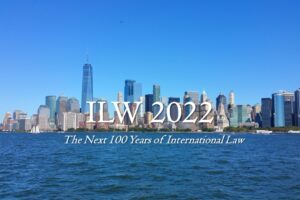A Binary in Crisis: Broadening the Functional Approach to the Law of Occupation (IHL Symposium)

A column of smoke after an Israeli bombing of the Gaza Strip; Mohammed Ibrahim
This piece is part of the American Branch’s third blogging symposium, examining the ILW 2025 theme of ‘Crisis as Catalyst in International Law’ from an International Humanitarian Law perspective. The International Humanitarian Law Committee sponsors this symposium; however, the views expressed in published works are solely those of the authors.
A Binary in Crisis: Broadening the Functional Approach to the Law of Occupation
by Oscar Pearce*
International Humanitarian Law (“IHL”) traditionally tells the following story of military occupation: one state successfully invades another, taking control of its territory. Legally, the invader is not the sovereign power in the territory. Factually, however, it has replaced the indigenous government’s authority with its own.
Occupations are thus states of exception, severing the bond between sovereignty and control of territory. In such abnormal circumstances, IHL applies constraints, duties, and authorizations to occupying forces, primarily sourced from the Hague Regulations and the Fourth Geneva Convention (Part III, Sections I and III). Collectively, this is the law of occupation. For a critical analysis of regulating such states of exception, see Ben-Naftali and Diamond.
In this post, I discuss how a recent crisis served as a catalyst for expanding the temporal scope of the law of occupation, before proposing to extend this expansion further, aiming to give full effect to the law’s purpose.
The Temporal Boundaries of Occupation
When does the law of occupation begin to apply, and when does it stop? For over a century, the answer was simple. Article 42 of the Hague Regulations states:
Territory is considered occupied when it is actually placed under the authority of the hostile army.
The occupation applies only to the territory where such authority is established, and in a position to assert itself.
Under this test, an occupier was classified as such when it had secured effective control of a territory. Symmetrically, when an occupier no longer exercised effective control, it was no longer an occupier.
This effective control threshold is high. See, for example, the ICTY’s guidelines from Naletilić and Martinović:
– The occupying power must be in a position to substitute its own authority for that of the occupied authorities, which must have been rendered incapable of functioning publicly;
– The enemy’s forces have surrendered, been defeated, or withdrawn. In this respect, battle areas may not be considered as occupied territory. However, sporadic local resistance, even successful, does not affect the reality of occupation;
– The occupying power has a sufficient force present, or the capacity to send troops within a reasonable time to make the authority of the occupying power felt;
– A temporary administration has been established over the territory;
– The occupying power has issued and enforced directions to the civilian population.
A Troubling Gap
Despite Israel’s 2005 “disengagement” from Gaza, it retained significant authority over the territory. Israel controlled Gaza’s air and sea, a no-go zone along the border, the local monetary market, customs duties, veto rights over large-scale construction, the population registry, and border crossings (see the 2015 Human Rights Council inquiry).
Without the law of occupation, Israel could continue acting as a quasi-occupying force, unrestrained by occupier obligations (nor empowered by authorizations): an unacceptable vacuum.
Absent “boots on the ground” and outright Israeli administration of the territory, however, it was difficult to conclude that Israel retained effective control. Moreover, even if Gaza was classified as subject to a traditional occupation, that was also undesirable. That would imply, for example, that Israel was duty-bound to enforce law and order.
Stuck between a rock and a hard place, the IHL community converged on a delicate path between the two: the functional approach.
The Functional Approach
The ICJ settled on the following solution:
Where an occupying Power, having previously established its authority in the occupied territory, later withdraws its physical presence in part or in whole, it may still bear obligations under the law of occupation to the extent that it remains capable of exercising, and continues to exercise, elements of its authority in place of the local government.
Though Israel no longer satisfied the effective control threshold, it had retained key elements of authority. Thus, its obligations remained “commensurate” with that ongoing control.
After the ICJ’s opinion – which followed support from academics, NGOs, and the ICRC – leading proponent Aeyal Gross declared the functional approach lex lata.
The functional approach is challenging to apply. Which elements of authority should be used to identify an applicable post-withdrawal setting? How is a “commensurate” obligation calibrated? These questions have not yet been conclusively answered.
However, this post concerns a preliminary issue: why confine this approach to scenarios where an occupying power has “previously established its authority in the occupied territory”?
Testing the Lex Lata
Consider the following hypothetical scenario:
Gaza Interrupted. Let ‘Gaza at T0’ refer to Gaza in 2019, under the state of partial occupation that prevailed at that time. Imagine that a party wins control of the Israeli Knesset in 2019 and ends all remaining Israeli influence over Gaza, such that the law of occupation clearly no longer applies. This is ‘Gaza at T1’. Then, in a 2021 election, momentum reverts, and the features of post-2005 Israeli control are reinstated. This, finally, is ‘Gaza at T2’. Since the occupation ended just 2 years earlier, Israel rapidly and remotely restores these levers of power.
Disregard the actual likelihood of these events, the relevant conclusion is conceptual. Gaza at T0 and T2 are substantively identical – Israel exercises significant authority over the territory but lacks effective control. The applicable legal regime differs entirely. The lex lata functional approach only covers partial occupations that arise after a full occupation is scaled back. Gaza at T2 involves a partial occupation established as such at the outset, which is clearly outside this scope.
Should different legal regimes govern Gaza at T0 and T2? I contend that there is no solid basis for distinguishing the two.
Perhaps, however, the lex lata functional approach would cover Gaza at T2 because it is not actually the start of a new occupation, but rather the messy end of an old one. Consider, though, the following:
The Selective Occupier. State B attacks State A. State A responds with a campaign of remote attacks against Region X, which was used as the base for State B’s attacks. Defeated, State B’s military withdraws from Region X. State A is reluctant to launch a full invasion of Region X. It wishes to assume the minimum level of control necessary to prevent attacks. In direct communications to civilians, State A assures Region X that it can continue to function largely as usual. However, State A imposes a curfew – which will be enforced by the drones that patrol Region X – and requisitions a hospital in Region X that sits on the border of State A for domestic purposes.
State A probably lacks effective control of Region X. Nevertheless, it has severed the bind between control and sovereignty, leaving a vacuum.
Those familiar with the law of occupation will note at least one possible violation above: Article 57 of the Fourth Geneva Convention prohibits (with narrow exceptions) the requisitioning of hospitals in occupied territories. Why apply this prohibition to scenarios that cross the effective control threshold, but not to those that do not? Even worse, why apply this to post-withdrawal partial occupations (eg, Gaza) but not to all partial occupations (eg, Region X)?
Below, I propose a test to fill these gaps.
Sketching a Generalized Functional Approach
Consider the following (inspired by the ICJ’s language):
Territory is occupied when it is actually placed under the authority of the hostile army. A State therefore occupies territory that is not its own when, and to the geographic extent that, it exercises effective control over it. Where a State lacks effective control but is capable of exercising, and in fact exercises, key elements of its authority in place of the local government, it shall bear obligations under the law of occupation commensurate with the degree of its control over the territory.
This rule upholds the principle that effective control triggers the full law of occupation. Where that threshold is not met, a secondary test is run: does the purported occupier exercise key elements of authority over the territory? When answered in the affirmative, the law of occupation will be activated.
I acknowledge that I have retained imprecise ICJ/ICRC phraseology: “key elements of authority”, “commensurate”. Flexibility is inherent in any functional, fact-based approach to law, but some general observations can be made. The traditional indicia of effective control (e.g., the capacity to enforce a curfew) are likely candidates to be “key elements of authority”. Regarding the balancing exercise implicit in “commensurate”, I would note that such balancing is already built in to positive occupier obligations (see Siegrist).
To return to first principles, however, recall that the law of occupation’s purpose is to govern states of exception. This generalized functional approach should thus be interpreted as catching scenarios wherein a purported occupier lacks effective control but nevertheless exercises exceptional public power in a foreign territory.
Conclusion
It took a humanitarian crisis to catalyze the development of the functional approach. We should not wait for the next crisis to refine it. I hope this proposal can contribute to aligning the law of occupation with its animating purpose: regulating the exceptional exercise of extraterritorial public power, and protecting civilians in the process.
 *Oscar Pearce is an incoming graduate lawyer at Herbert Smith Freehills Kramer, Sydney. Oscar studied at the Australian National University, where he specialized in public international law. This work is derived from an Honours thesis written under the supervision of Dr. Wanshu Cong.
*Oscar Pearce is an incoming graduate lawyer at Herbert Smith Freehills Kramer, Sydney. Oscar studied at the Australian National University, where he specialized in public international law. This work is derived from an Honours thesis written under the supervision of Dr. Wanshu Cong.
Deprecated: Method hb_options is deprecated since Highend version 3.7. Use highend_option instead. in /home/abila/public_html/wp-content/themes/HighendWP/functions/deprecated.php on line 611



